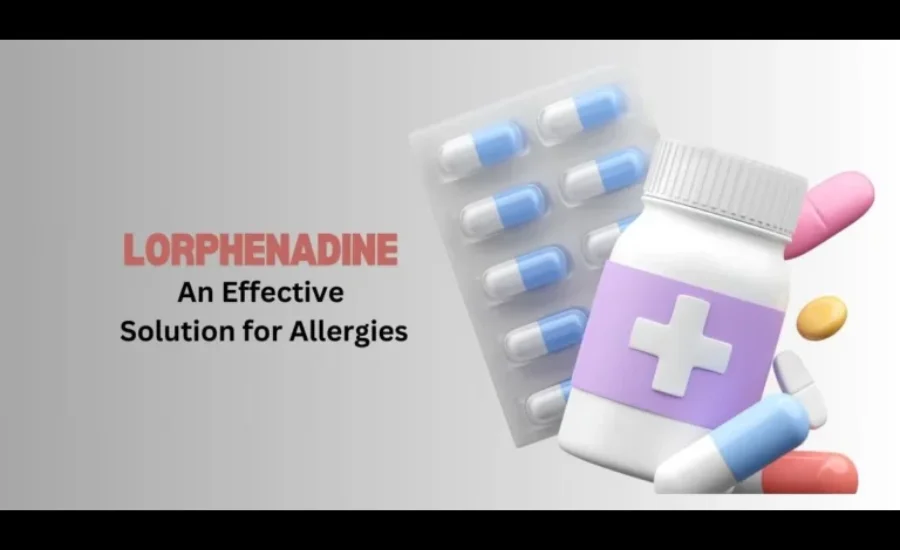Allergies can turn a beautiful day into a challenge, with symptoms like sneezing, itchy eyes, and persistent discomfort disrupting daily life. Fortunately, Lorphenadine provides a dependable solution for managing these symptoms. As a trusted antihistamine, it brings relief to individuals dealing with seasonal allergies or other allergic conditions. Let’s explore why Lorphenadine is a reliable choice for taking back control of your well-being and enjoying life uninterrupted.
Understanding Lorphenadine: A Comprehensive Guide
Lorphenadine belongs to the second-generation antihistamines, a class developed to improve upon the limitations of earlier medications. Unlike the first-generation antihistamines, such as diphenhydramine, second-generation antihistamines are highly selective in their action. This means they target the H1 histamine receptors specifically, reducing allergic symptoms while minimizing off-target effects, such as sedation.
The innovation behind Lorphenadine lies in its ability to cross the blood-brain barrier at a much lower rate than its predecessors. This scientific breakthrough ensures that the central nervous system is less affected, allowing users to remain awake, alert, and functional throughout their day.
Allergies are a common concern for many, often interrupting daily life with sneezing, itching, and other uncomfortable symptoms. To combat these reactions, modern medicine has developed antihistamines like Lorphenadine, a trusted solution for allergy relief. This medication offers a non-drowsy alternative to traditional treatments, providing targeted relief from allergic symptoms while allowing individuals to maintain their daily routines.
What Makes Lorphenadine Unique
Lorphenadine is a second-generation antihistamine designed to address allergic reactions effectively while minimizing side effects. Unlike older medications, it offers a more refined approach, targeting specific receptors without causing significant sedation. This precision in action makes it a preferred choice for treating conditions like hay fever, chronic hives, and seasonal allergies.
How Lorphenadine Works
When allergens invade the body, they trigger the release of histamine, a compound that causes symptoms such as itching, swelling, and redness. Lorphenadine acts as a selective H1-receptor antagonist, which means it blocks histamine from binding to receptors and initiating allergic responses. This targeted mechanism helps alleviate discomfort while maintaining alertness, a notable improvement over older antihistamines.
Lorphenadine for Respiratory Conditions

Respiratory conditions, such as allergic asthma and exercise-induced bronchospasm, may also benefit from Lorphenadine. By reducing histamine’s effect on the airways, the medication can help ease symptoms like wheezing and shortness of breath.
While it is not a substitute for bronchodilators or corticosteroids, its role as an adjunct therapy can enhance overall symptom control for patients with mild to moderate respiratory allergies.
The Development and Evolution of Lorphenadine
The journey of Lorphenadine began with a goal: to create an effective antihistamine that minimized the drowsiness associated with earlier medications. Researchers in the late 20th century succeeded in developing this second-generation antihistamine, focusing on improving patient comfort and compliance. Since its introduction, Lorphenadine has become a staple in allergy management, backed by extensive clinical research and widespread use.
Clinical Applications of Lorphenadine
Lorphenadine is primarily prescribed for managing allergic conditions, including hay fever, allergic rhinitis, and chronic urticaria. It provides relief from sneezing, runny nose, and itchy eyes, helping individuals regain control over their daily activities. Additionally, Lorphenadine has shown effectiveness in treating certain skin conditions and muscle-related discomforts caused by underlying allergic reactions.
Lorphenadine extends its utility beyond allergic rhinitis by demonstrating effectiveness in managing non-allergic rhinitis, a condition often triggered by irritants such as smoke, strong odors, or sudden weather changes. This medication helps alleviate symptoms like nasal congestion, sneezing, and a runny nose, offering broader relief for individuals affected by such irritants. Its role in addressing skin-related conditions is also significant. Lorphenadine is frequently used to manage atopic dermatitis and contact dermatitis, where its antihistaminic properties help reduce itching and inflammation caused by allergens. Additionally, its ability to stabilize mast cells plays a key role in preventing flare-ups, providing consistent symptom relief. Emerging research further suggests that Lorphenadine could have a supportive role in managing post-viral syndromes. In these scenarios, chronic inflammation and allergy-like symptoms often persist even after the primary infection has resolved. While this is not yet a standard application, ongoing studies are exploring the medication’s potential to provide relief in such cases, pointing to a promising avenue for future therapeutic strategies.
Benefits of Lorphenadine

One of the standout benefits of Lorphenadine is its ability to provide allergy relief without causing significant drowsiness. This is especially valuable for individuals who need to remain alert throughout the day. Furthermore, its long-lasting effects mean fewer doses are required, offering convenience and consistent symptom management.
Safety and Considerations
While Lorphenadine is generally well-tolerated, certain precautions are essential. Individuals with pre-existing conditions, such as liver or kidney disease, should consult their healthcare provider before starting treatment.
Dosage and Usage
For adults and children over 12 years of age, the typical dosage is 10 mg once daily. Children aged 6 to 11 years may be prescribed a lower dose, typically 5 mg once daily. It is important to follow the prescribed dosage and consult a healthcare provider for any adjustments, particularly for patients with renal or hepatic impairments.
Potential Side Effects
Like any medication, Lorphenadine may cause side effects, though they are generally mild. Serious reactions are rare but require immediate medical attention if they occur.
Gastrointestinal upset, such as nausea, abdominal pain, or bloating, may occasionally occur, especially if the medication is taken on an empty stomach, but these effects can often be mitigated by taking the medication with food. Neurological symptoms, though uncommon, have also been reported and may include dizziness or restlessness, particularly in cases where the recommended dosage is exceeded.
Managing Drug Interactions
Lorphenadine may interact with other medications, potentially altering its effectiveness or increasing the risk of side effects. It is crucial to inform your healthcare provider about all medications you are currently taking, including over-the-counter drugs and supplements. Avoiding alcohol while on Lorphenadine is also recommended, as it can enhance drowsiness.
Addressing Concerns About Resistance
Repeated use of antihistamines like Lorphenadine over long periods has raised concerns about potential tolerance or resistance. However, research suggests that Lorphenadine maintains its efficacy over time, provided it is used appropriately. For individuals who feel it becomes less effective, a consultation with a healthcare provider may reveal other underlying factors, such as an increased allergen load or the need for combination therapy.
Who Should Avoid Lorphenadine
Certain individuals may need to avoid Lorphenadine or use it with caution. These include those with severe liver or kidney disease, as well as individuals allergic to the drug or its components. A thorough medical history should be reviewed with a healthcare provider to ensure safe and effective use.
Comparisons with Other Antihistamines

Lorphenadine stands out from competitors due to its balanced profile of efficacy and tolerability. When compared to other second-generation antihistamines like cetirizine or loratadine, it is often preferred for its lower sedation risk and slightly longer duration of action.
Moreover, Lorphenadine’s onset of action is relatively rapid, often beginning to work within 30 minutes of ingestion. This quick relief is particularly beneficial for individuals experiencing sudden allergy flare-ups.
Lorphenadine During Pregnancy and for Children
The safety of Lorphenadine during pregnancy remains a topic of ongoing research. While some studies suggest it may be safe, expectant mothers should consult their healthcare provider for personalized advice. For children, Lorphenadine is generally considered safe when used under medical supervision and in age-appropriate dosages.
The use of Lorphenadine in children requires tailored dosages due to differences in metabolism, making it essential to follow healthcare provider recommendations. It is often favored over first-generation antihistamines for pediatric patients because of its reduced risk of sedation and safer side effect profile. For elderly patients, dosage adjustments may be necessary to account for potential drug interactions or diminished kidney function. Lorphenadine is considered a suitable option for older adults when used under proper medical supervision, ensuring effective management of symptoms with minimized risks.
Patient Education and Advocacy
Empowering patients with accurate information about Lorphenadine is key to its effective use. Understanding the importance of adherence, proper storage, and avoiding contraindicated substances (like alcohol or certain over-the-counter medications) ensures better outcomes and safety.
For individuals new to antihistamines, educating them on what to expect in terms of relief and side effects can build confidence in the treatment plan. Healthcare providers often emphasize regular follow-ups to adjust dosages or switch medications if needed.
Future Research and Innovations
As medical science advances, research into antihistamines like Lorphenadine continues. Scientists are exploring new formulations to enhance its efficacy and reduce potential side effects further. Additionally, studies are examining its role in managing emerging allergens and its potential use in combination therapies.
Lorphenadine’s Role in Modern Allergy Management

Lorphenadine has earned its place as a trusted solution for allergy relief. Its targeted action, minimal side effects, and convenience make it a standout choice for managing a wide range of allergic conditions. By offering effective symptom control without compromising daily life, it helps individuals reclaim their well-being and enjoy life to the fullest.
Final Words
Allergies disrupt daily life with symptoms like sneezing, itching, and discomfort, but Lorphenadine provides effective relief. As a second-generation antihistamine, it selectively targets H1 histamine receptors to alleviate symptoms without significant sedation, unlike older medications. This precision allows individuals to remain alert while managing conditions such as hay fever, allergic rhinitis, and chronic hives.
Lorphenadine’s long-lasting effects and minimal side effects make it a preferred choice. It also benefits respiratory conditions like allergic asthma and certain skin disorders, reducing inflammation and preventing flare-ups. Emerging research suggests potential in managing post-viral syndromes, expanding its therapeutic applications.
Safe for most, it may cause mild side effects like headache or nausea. Rarely, it can affect heart rhythm in high doses, requiring caution for patients with heart conditions. Suitable for children and elderly patients with adjusted dosages, Lorphenadine remains an accessible option for diverse age groups. Its efficacy and convenience have solidified its role in modern allergy management, empowering individuals to enjoy life uninterrupted.
FAQs
1. What is Lorphenadine used for?
Lorphenadine is used to treat allergies such as hay fever, allergic rhinitis, chronic hives, and certain skin conditions. It also helps manage symptoms like sneezing, runny nose, itching, and watery eyes.
2. How does Lorphenadine work?
Lorphenadine is a second-generation antihistamine that blocks H1 histamine receptors, preventing the allergic response that causes symptoms like itching, swelling, and redness.
3. Does Lorphenadine cause drowsiness?
Lorphenadine is non-sedating for most users due to its reduced ability to cross the blood-brain barrier, making it less likely to cause drowsiness compared to older antihistamines.
4. What is the recommended dosage for Lorphenadine?
For adults and children over 12, the typical dosage is 10 mg once daily. For children aged 6 to 11, the usual dose is 5 mg daily. Always follow your doctor’s guidance.
5. Can Lorphenadine be used for non-allergic rhinitis?
Yes, Lorphenadine is effective in treating non-allergic rhinitis triggered by irritants like smoke, strong odors, or weather changes by alleviating symptoms such as congestion and sneezing.
6. Is Lorphenadine safe for children?
Yes, Lorphenadine is safe for children when used in age-appropriate doses under medical supervision. It is often preferred over older antihistamines due to its low sedation risk.
7. Can pregnant or breastfeeding women use Lorphenadine?
Pregnant or breastfeeding women should consult their healthcare provider before using Lorphenadine to ensure safety, as research in these populations is still ongoing.
8. What are the common side effects of Lorphenadine?
Common side effects include dry mouth, headache, fatigue, and nausea. Serious side effects are rare but may include changes in heart rhythm or dizziness in some individuals.
9. Can Lorphenadine interact with other medications?
Yes, Lorphenadine can interact with other drugs, including sedatives and alcohol, potentially enhancing drowsiness.
10. How quickly does Lorphenadine work?
Lorphenadine typically starts working within 30 minutes of ingestion, providing quick relief from allergy symptoms and lasting for up to 24 hours.
For effective allergy relief and trusted wellness solutions, explore Lorphenadine at Discover Outlooks today!
